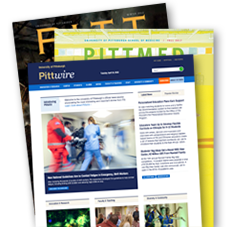Electrons 'In Limbo' Seen for First Time
PITTSBURGH—Hrvoje Petek, University of Pittsburgh professor of physics and codirector of Pitt's Gertrude E. and John M. Petersen Institute of NanoScience and Engineering (PINSE), has published two papers in recent weeks that literally illuminate how electrons behave on various surfaces.
In the first paper, Petek and Miroslav Nyvlt of Charles University in Prague explored the properties of metals under intense light—a situation "where the classical physics of electron emission from metals emerges from its quantum roots," says Petek. They found that when light of a certain energy and intensity is shone onto a metal surface, a few electrons in the metal become stuck on the surface (that is, they are neither emitted from nor reabsorbed into the metal). As Petek puts it, the electrons are "in limbo."
These electrons undergo the process of "total internal reflection"—a process well known for light, but observed by Petek and Nyvlt for the first time in electrons.
These findings, published in the March 3 issue of Physical Review Letters (PRL), could lead to the ability to transmit electrons, without scattering, over larger distances than previously possible. For example, electrons on the surface of carbon nanotubes could be excited to make "very small and very fast" transistors, Petek says.
"We anticipate that these elusive electrons will provide exquisite probes for how photons and electrons interact with metal surfaces," he adds.
In Petek's second paper, published in the current issue of Science, he and Pitt Professor of Chemistry Kenneth Jordan, a PINSE researcher, make new progress toward extracting hydrogen from water using titanium dioxide as a catalyst.
In a May 2005 Science paper, Petek and Jordan presented their findings on the properties of water on the surface of titanium dioxide. In their current experiment, they used methanol instead of water, because they discovered that excited electrons last longer in methanol than in water, allowing chemical reactions to be observed.
This research shows how protons in methanol molecules move in such a way that they control the reabsorption of electrons into the titanium dioxide. Such motion, correlated between protons and electrons, is needed to convert light into chemical energy on solid surfaces, as well as by light-harvesting proteins.
PINSE is an integrated, multidisciplinary organization that brings coherence to the University's research efforts and resources in the fields of nanoscale science and engineering. More information about PINSE can be found at www.nano.pitt.edu.
The work for the PRL paper was performed at the Max Planck Institute of Microstructure Physics in Halle, Germany, where Petek was an Alexander von Humboldt Senior Scholar and Nyvlt was the group leader. Other authors on the paper are Francesco Bisio, now at the University of Genoa; Jirka Franta, now at Charles University; and Jurgen Kirschner, director of the Max Planck Institute.
That work was supported by the Alexander von Humboldt Foundation, the U.S. National Science Foundation, the Italian National Research Council, and the Czech Ministry of Education.
In addition to Petek and Jordan, authors on the Science paper are postdoctoral fellows Jin Zhao and Ken Onda and graduate student Bin Li, all of Pitt's Department of Physics and Astronomy, and Jinlong Yang of the University of Science and Technology of China. The work was supported by the U.S. Department of Defense Multidisciplinary University Research Initiative program, the New Energy Development Organization of Japan, and the National Science Foundations of the United States and China.
###
3/14/06/tmw
Media Resources
Schools of the Health Sciences Media Relations
For more information about Pitt's schools of dental medicine, health and rehabilitation sciences, medicine, nursing, pharmacy, and public health, click here >
To locate stories from health science schools prior to 2013, visit the UPMC news archives »
Urgent Question?
University of Pittsburgh news reps are available to answer urgent media inquiries. Outside of regular business hours (Mon-Fri, 8:30 a.m.-5 p.m.), please email us at media@pitt.edu.
News reps for University of Pittsburgh Health Sciences schools can be reached outside of regular business hours through the paging operator at 1+412-647-2345.


